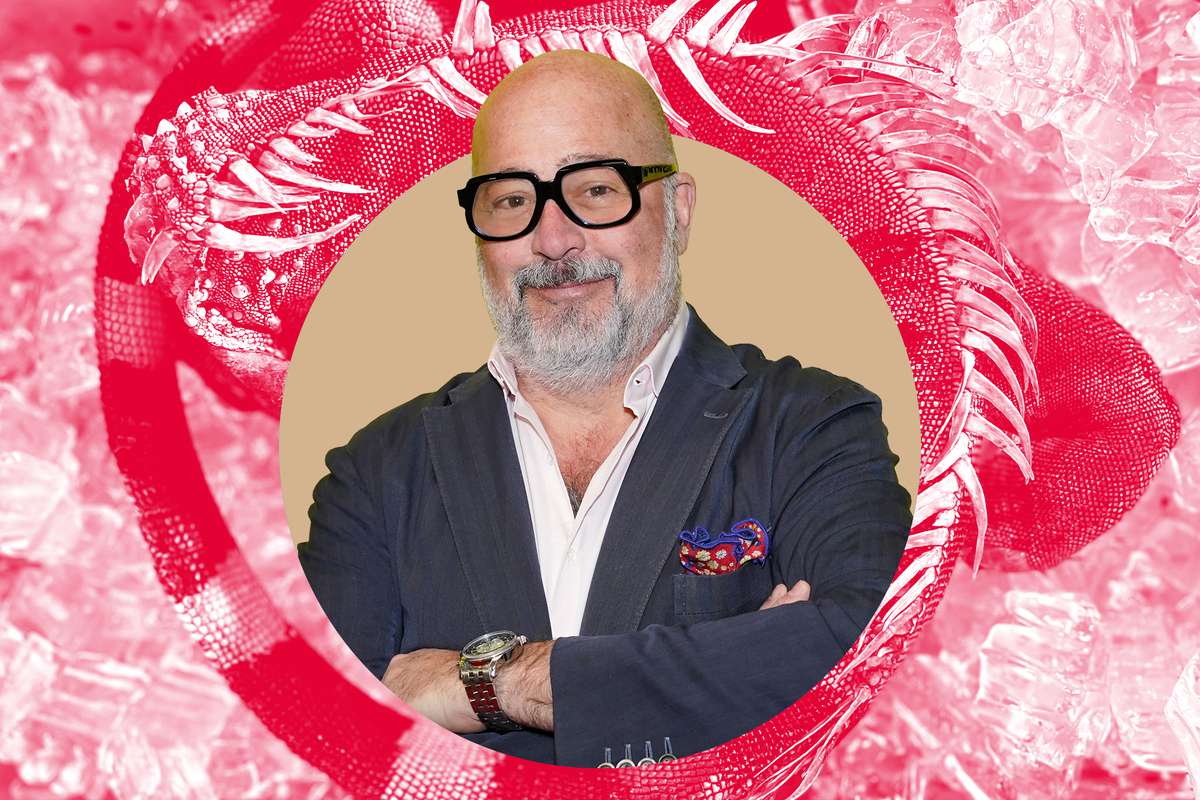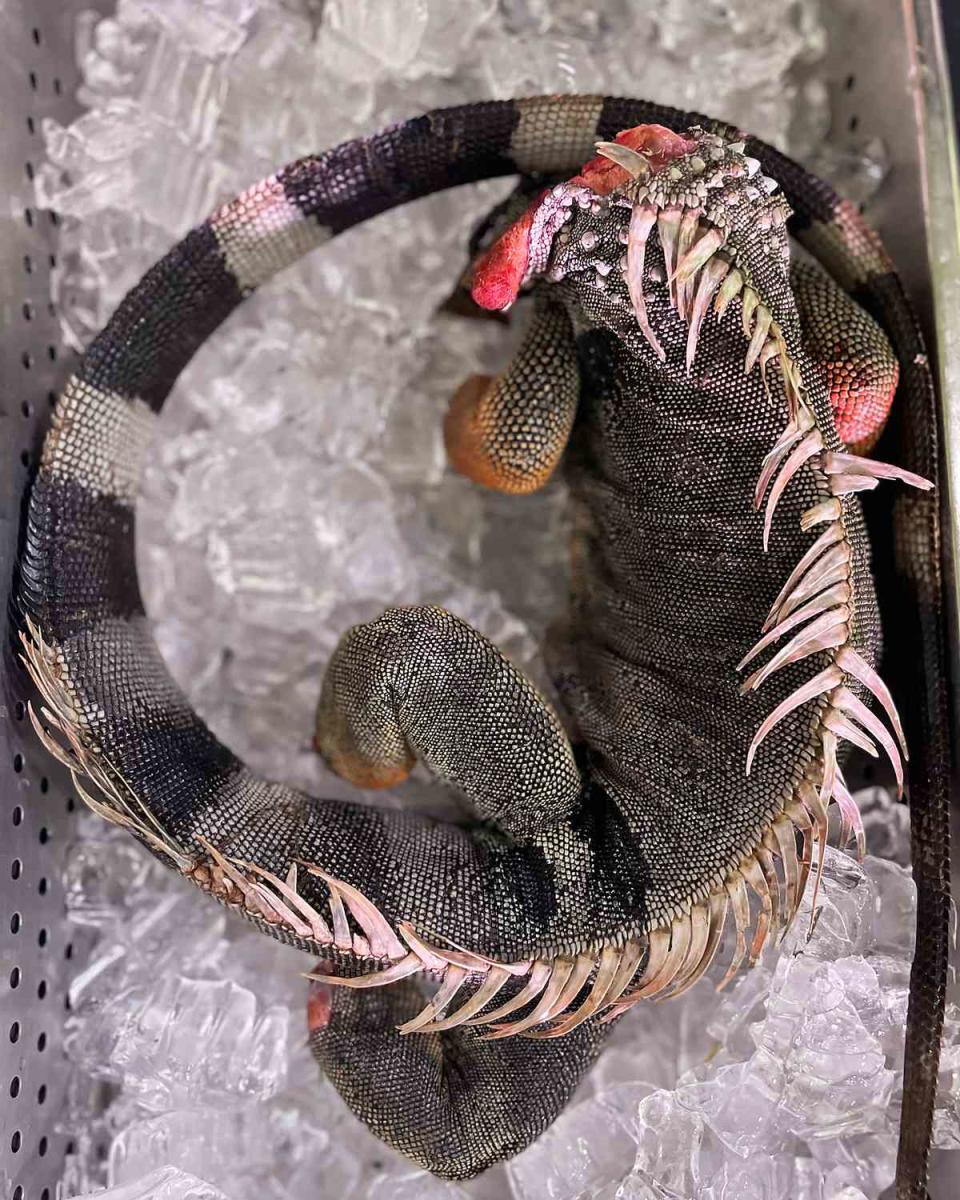Why Andrew Zimmern Thinks You Should Cook an Iguana for Dinner Tonight

- Oops!Something went wrong.Please try again later.
Amy E. Price / Getty Images; Kat Kinsman
Andrew Zimmern is well aware that you're most likely not going to be whipping up a casual lizard entree for dinner tonight, but he'd like you to be prepared should the opportunity — or even the need — arise. In fact, that's how he ended up onstage at the Food & Wine Classic in Aspen, doing a classic meunière preparation on iguana meat.
The chef, author, and TV host had originally intended to demonstrate a Red Lionfish with Brown Butter and Capers recipe along with Broiled Kasu Marinated Carp with Somen Noodles as part of his "There Are Other Fish in the Sea: Falling in Love with Invasive Species" seminar, but nature and supply chains are fickle beasts, and at the list minute, a switcheroo. The crowd walked into to see a headless, but otherwise intact iguana on the prep counter, and had the exact reaction that Zimmern anticipated — and was quick to call them on it.
RELATED: These Invasive Carp Are Getting a New Name So Americans Will Eat Them
"I put this animal up here because I think it's important that we all know where our food comes from. If I put a chicken up here, there would be no umbrage. There would be no heart palpitations," he said. "The fact that this is a reptile — and we don't eat reptiles in this country, — is shocking to some people. I don't do this to shock; I think we all need to know where our food comes from, just like we do chickens."

Kat Kinsman
And where do iguanas come from? Too darned many places if you ask some Southern Floridians. There, Zimmern says, iguanas are considered an invasive species, wreaking havoc on the ecosystem, and subsequently killed and tossed by the ton into Dumpsters even in communities with high rates of food insecurity. As a Goodwill Ambassador for the United Nations World Food Programme, Zimmern is no slouch on the topic of food access, and the role that cultural perceptions play in a population's willingness to embrace new foods — and how a little marketing magic can whet the senses for ingredients that have been embraced in other parts of the world.
"Why not do what they do in Trinidad and Tobago, where they make a fabulous, green curry out of it?" he mused. "Or why not apply a classic French technique of glazing the pan with white wine, capers, and showers?" That, he explained, is a meunière — a technique often associated with sole, but applicable to any cutlets that might do well dusted with flour (the term translates to "in the style of the miller," he explained) and sautéed. That's it.
"It has nothing to do with the capers, butter, white wine, anything else you might throw in there," Zimmern noted. "That's a misconception. Anything, any cutlet, any small piece of meat, fish. or poultry that is dusted in flour and sauteed is technically done in the style of the miller."
But you're not just dredging that iguana leg or backstrap in raw flour and calling it dinner. Zimmern suggested using a cup per pound of meat and "almost overseasoning" with a spice blend of your choice — in this case, his own commercial blend that includes citrus and herbs. While the meat rested and came to room temperature —a step he said allows it to start cooking immediately once it hits the pan — he heated oil in a pan (enough to coat the bottom, as iguana meat has no fat of its own, hence the sitting in the sun all day), and explained how the capers he'd be using had been soaked, rinsed, and dried to remove a bit of their salty sting so they wouldn't overpower the rest of the dish. Once the oil was sufficiently shimmering, he added the dusted cutlets, turned the heat up about 25% and cocked an ear toward the skillet to listen.
"I can hear the sound of the moisture changing in my pan, and that clued into me first," Zimmern explained. "We cook with all of our senses. When moisture comes out of meat, it sizzles in oil. When you hear the sizzling stop, it has evaporated, and it may be time to turn them over."
RELATED: Cooking with Wine
Once the meat seared to his liking on both sides, Zimmern used a slotted spoon to keep the precious iguana cutlets from sliding out while he tipped the excess fat from the pan, then deglazed with butter, shallots, black and white pepper, a spritz of calamansi vinegar, and a glug of white wine to make a piquant sauce to pour over the cutlets he'd nestled onto a plate with roasted potatoes and asparagus. A shower of capers, and here was a plate of iguana meunière fit for company, or a casual night in.
"No one's going home tonight and making iguana," Zimmern admitted, "but the idea of what we're doing here is really important and you have another great recipe." And it's one that just might make a little difference.
"If everyone in this country took one meal out of the wild, skipped one meal a week, and took one meal out of the laboratory — a little can of something with all the nutrients you need for a day — we would eliminate three out of 21 meals, a seventh of our diet," Zimmern mused. "Imagine the lessening of pressure that would mean on the already oppressed food system we've all been living through for the last couple years, and which has finally made it to the front pages."
And with an iguana dish this delicious, you just might wanna try.
Check out more chef cooking tips from the 2022 Food & Wine Classic in Aspen.

